Serbia E-Commerce Market Size
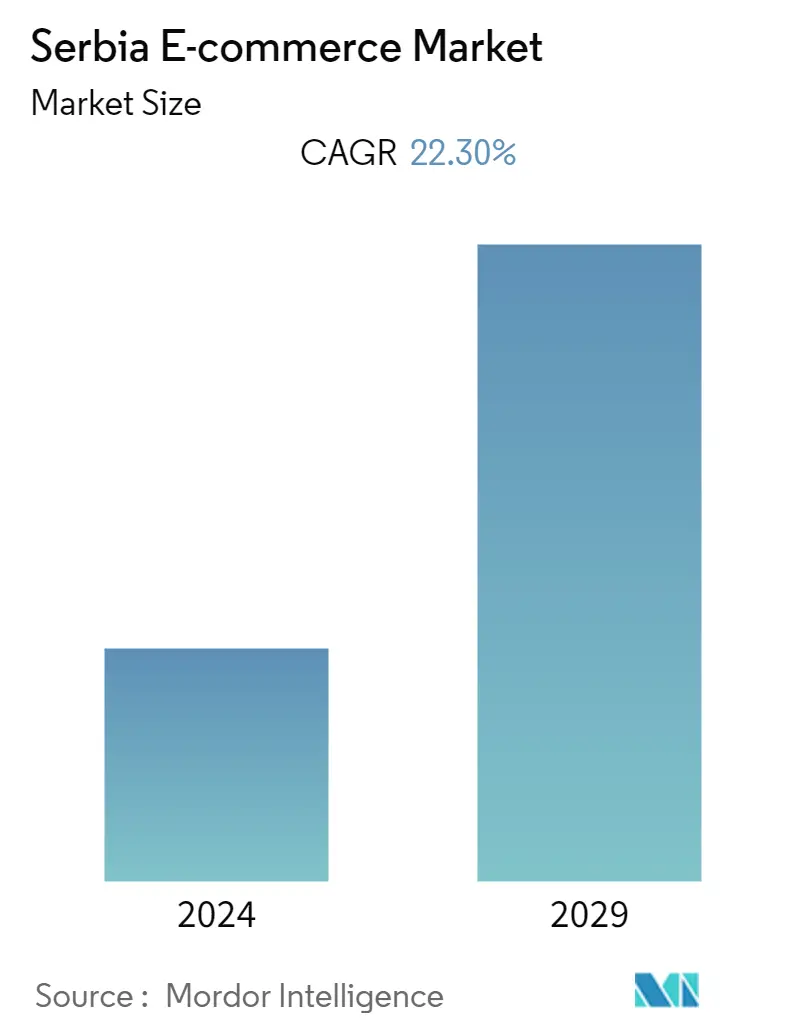
| Study Period | 2019 - 2029 |
| Base Year For Estimation | 2023 |
| Forecast Data Period | 2024 - 2029 |
| Historical Data Period | 2019 - 2022 |
| CAGR | 22.30 % |
| Market Concentration | Medium |
Major Players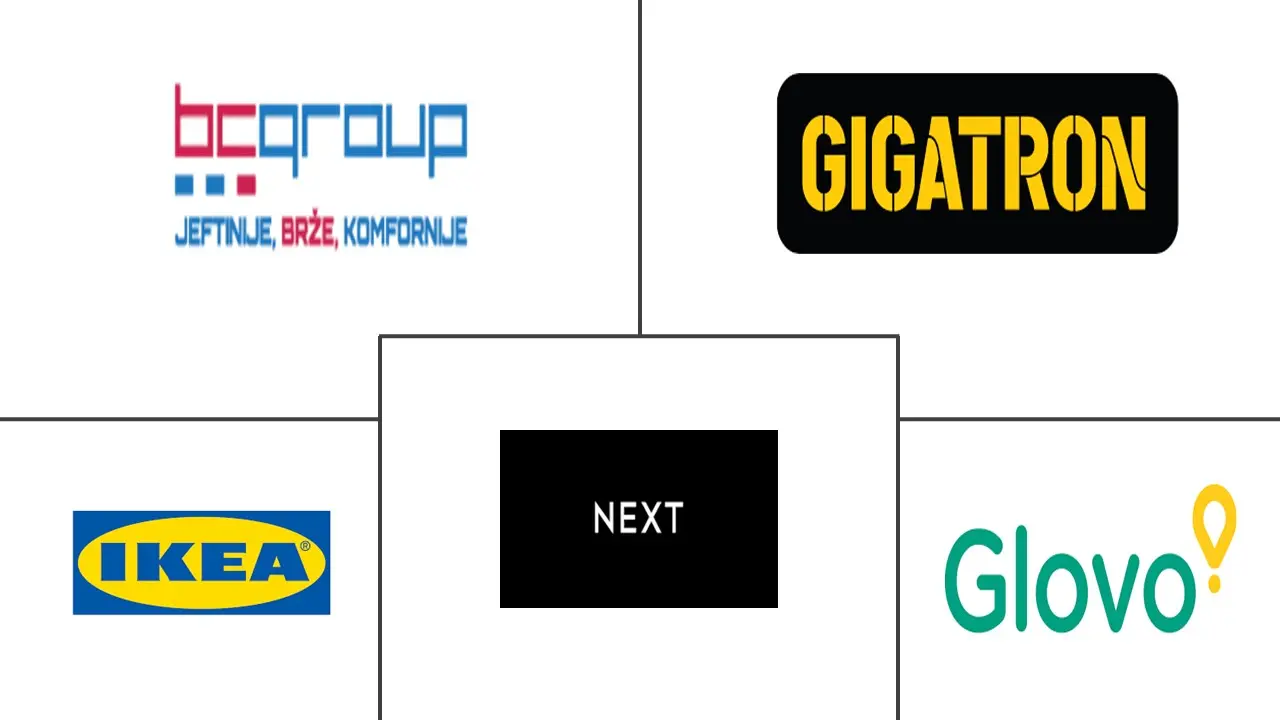
*Disclaimer: Major Players sorted in no particular order |
Need a report that reflects how COVID-19 has impacted this market and its growth?
Serbia E-Commerce Market Analysis
E-commerce is becoming an increasingly popular form of purchasing goods and services among the citizens of Serbia. The number of internet users in the Republic of Serbia is undoubtedly increasing daily. The e-commerce market in Serbia is expected to register a CAGR of 22.3% during the forecast period (2022 - 2027).
The Internet is widespread in Serbia, but Serbia lags behind the developed countries of Western Europe. Serbia is one of the leading countries in the West Balkan region in terms of absolute and relative numbers of online shoppers. However, this is far behind Western European countries, where more than 80% of the population buys at least one product online.
The development of the digital economy, and therefore the growth of e-commerce, is one of the Government's priorities in the country. The Program for the Development of E-Commerce in the Republic of Serbia for the period 2020 was adopted, with an Action Plan having a set of measures and actions aimed at improving all elements in the field of e-commerce boosting customer assurance in online shopping, preserving the position of e-merchants, improving logistics flows, enabling electronic payment, etc.
Consumer spending has improved in 2020 and early 2021, and growth is expected to exceed the EU average by 2022. In 2020, the National Bank of Serbia recorded a significant increase in online purchases primarily attributed to the COVID-19 pandemic. However, household spending on non-food and services is expected to witness restrained growth beyond this period as consumers are unable to shift spending to less essential items due to the relatively low projected long-term GDP growth.
However, the Government has introduced new obligations for postal service providers to identify the sender and recipient of parcels. Implementing e-commerce is critical, and many government agencies still avoid public consultations and RIA. This can make long-term business planning a significant challenge, and access to adequate financial resources for Serbian consumers/importers could also be an issue.
According to the International Trade Administration, Serbian e-commerce doubled during the COVID-19 pandemic. Online grocery sales witnessed the most significant surge, followed by clothing and shoe sales and technology sales. According to the Serbian Statistics Bureau, Serbia had 3.3 million online customers in 2020.
Serbia E-Commerce Market Trends
This section covers the major market trends shaping the Serbia E-commerce Market according to our research experts:
Internet usage to drive the e-commerce market in the country
The intensive development of digital technologies, the shorter lifecycle of products, the internet, social media, smartphones, and educated, connected, and informed customers had transferred the communications and the whole business online. The internet and social networks have enabled people to interact globally with minimal effort but made the battle for attaining and sustaining the competitive advantage complicated and uncompromising. Also, shopping has drastically changed due to the usage of digital technologies.
Serbia's digital economy is growing, and ICT is becoming the most prosperous part of the economy, but most initiatives come from the private sector. Broadband is still in its infancy, but Serbia is one of the world's leading mobile phone providers. Internet speeds in Serbia are much slower than in Europe and also more expensive per megabyte of data transfer.
Moreover, due to poor infrastructure, most of the ICT businesses are located in the major cities of Belgrade, Novi Sad, and Niš. Serbia has many start-ups in the region, but its survival rate is low. In the areas of research, pre-seed, and seed stages, businesses lack continuous and substantive financial support. Since COVID-19, this has been rising with more people adopting e-commerce solutions.
The development of Serbian telecommunications almost corresponds to the European Union average. With an average download speed of 50.67 megabits/sec for fixed-line broadband internet, Serbia is ranked 69th in international comparison. On the mobile internet, tablets, and smartphones, Serbia ranks 44th with a download speed of 43.05 Mbit/s. These changes in internet speeds leverage the demand and development of the internet in the country.
E-commerce players with products and existing e-commerce processes grew mainly during the COVID-19 pandemic in 2020. Despite the re-opening of malls, there is still higher spending on digital channels. Grocery shopping online was found predominantly within the bigger cities, and these stores grew, but interestingly, only a limited percentage of overall grocery market sales are online. They had logistics and capacity problems, but many had their delivery and were quick to rise to the challenge. However, the increasing internet consumption in the country has positively influenced the use of e-commerce platforms.
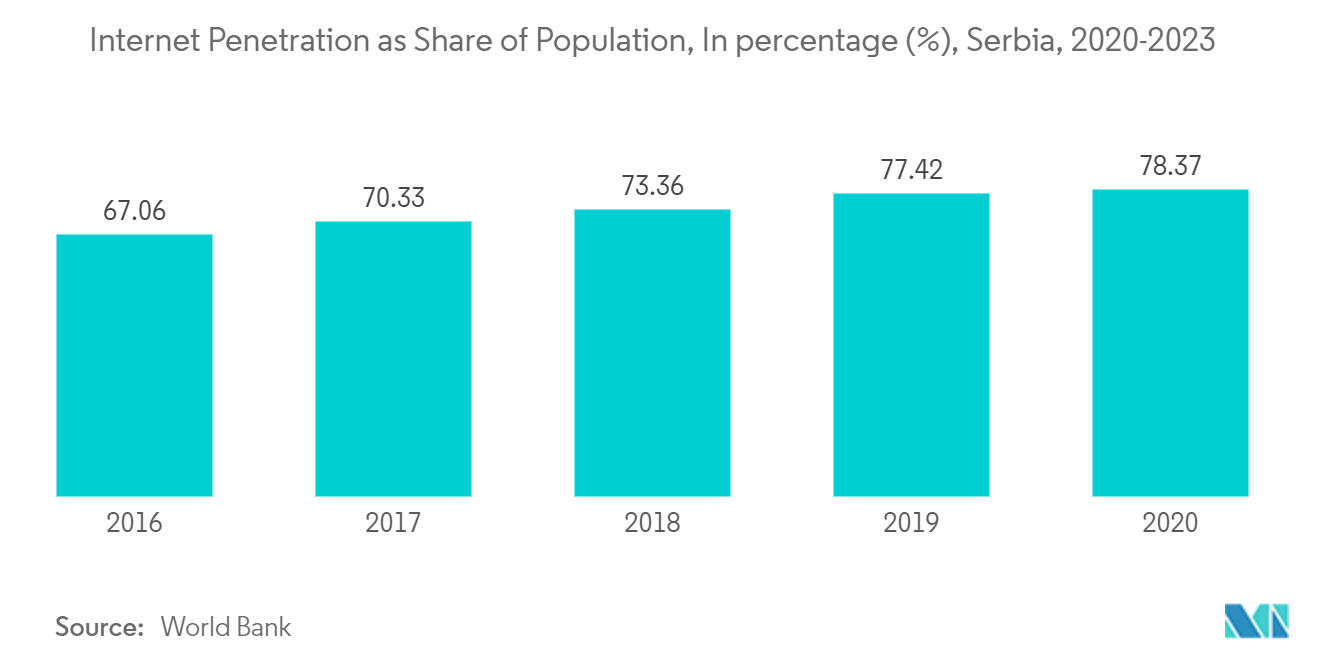
Online Shopping is leveraging the Fashion E-commerce market in the country
The fashion industry has been in focus with the common population largely investing in the online shopping of various clothes and apparel in the country. A significant number of customers bought clothes and sports products, closely followed by online sports equipment and home appliances.
In October 2021, several fashion brands left Asia, and their production expanded to Serbia and Croatia. The Italian company Benetton has already developed output in Croatia, Serbia, and other regions and plans to split its production capacity between Asia. Due to the shortage of ships, the average delivery time from Asia has increased from 4 months to 5 months. As a result, the company plans to increase production in Serbia, and more regions, working with suppliers in Egypt and Turkey.
Also, in July 2020, United Group opened a new chapter in business with the launch of the local e-commerce online shopping platform shoppster.com for Serbian shoppers. Initially, Shoppster offered over 20 popular product categories, including electronics, household items, gardens, tools, fashion, children's items, kitchen items, etc., with a range of products to meet the needs of discerning customers. Continue to expand intensively.
Further, in collaboration with the Ministry of Finance - Customs Administration, the national postal service, Posta Srbije created two services for its customers PostExport and PostPak - to facilitate the export of goods and make better conditions for cross-border eCommerce expansion. In addition, there are several private logistics service providers.
According to Serbia's Trade Development Strategy 2020, some of the main goals include the development of new trade and trade network structures, internationalization of trade, and intensifying competition. This strategy further aims to support small and medium enterprises, e-commerce development, consumer protection, and harmonization of the framework of Serbia with the EU. This helps the growth of the country's fashion industry and other retail businesses.
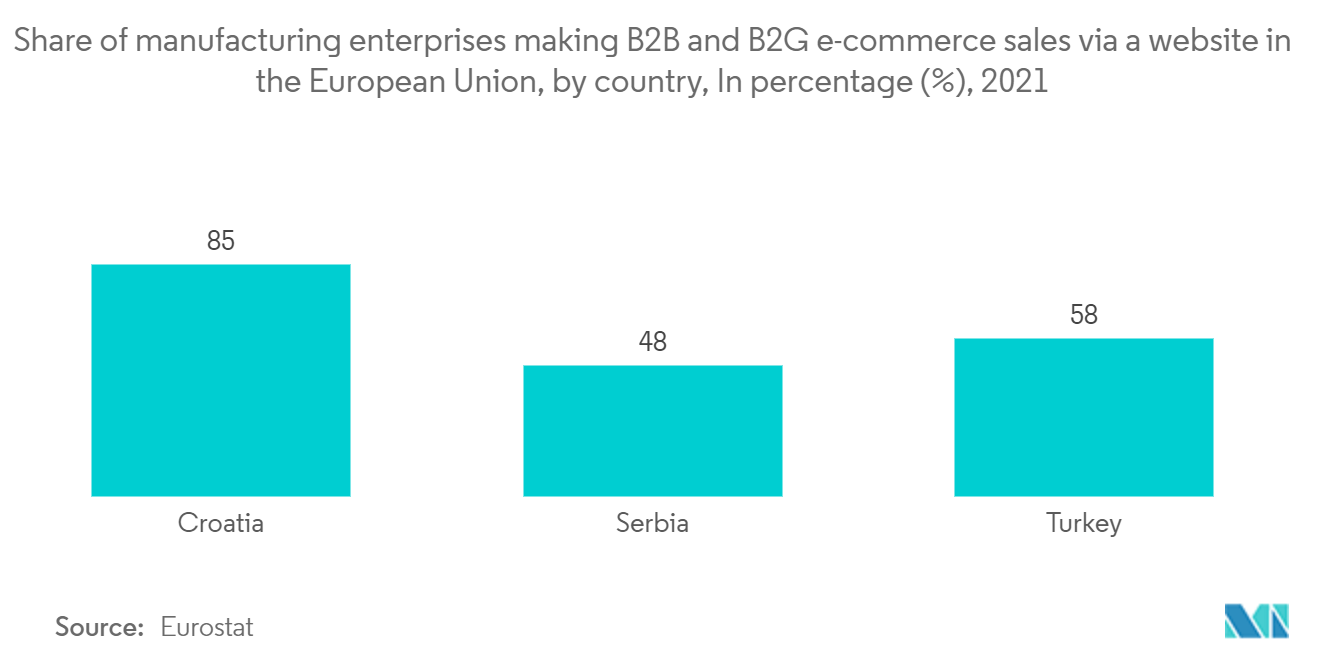
Serbia E-Commerce Industry Overview
Serbia's e-commerce market is moderately fragmented by large domestic companies. In addition, competition is intensifying with new entrants in the country that offer innovative online shopping technologies and solutions.
May 2022 - Sports Vision, a company with a significant presence in Serbia, added a new product from Columbia, the latest brand dedicated to the design of outdoor products that ensures that everyone can stay active outdoors for as long as possible. Columbia is one of the sports brands when it comes to the range of the outdoors. By turning its passion for the outdoors and strengthening its innovative spirit through technological development and product performance improvement, the company aims to provide its customers with the best outdoor protection.
September 2021 - Technomanija expanded its product portfolio with one of the world's leading white goods brands featuring quality and innovation that provides maximum convenience and adaptability to consumers in Serbia, that too only on Tenomanija. Moreover, the product is available only at selected Technomanija retail stores and online stores. Customers will be familiar with the great Haier range and will be able to choose the device for themselves and their families.
Serbia E-Commerce Market Leaders
Next Retail Ltd.
Gigatron
Glovo
Ikea Systems BV
BC Group
*Disclaimer: Major Players sorted in no particular order
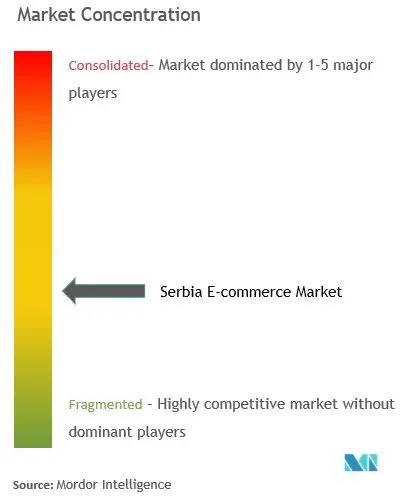
Serbia E-Commerce Market News
March 2022 - Technomanija offers a new smartphone brand known as Tecno. Tecno Mobile is one of the first mobile phone brands of Transsion Holdings. This company is engaged in high technology, which has research, development, production, sales, and servicing of mobile communication products.
May 2021 - Glovo boosts its footprint in Central and Eastern Europe, additionally developing its operations in Bosnia Herzegovina, Bulgaria, Croatia, Montenegro, Romania, and Serbia. Glovo acquired the Foodpanda brand in Romania and Bulgaria, the Donesi brand in Serbia, Montenegro, Bosnia and Herzegovina, and Pauza in Croatia in deals worth a total value of EUR 170 million.
Serbia E-Commerce Market Report - Table of Contents
1. INTRODUCTION
1.1 Study Assumptions and Market Definitions
1.2 Scope of the Study
2. RESEARCH METHODOLOGY
3. EXECUTIVE SUMMARY
4. MARKET INSIGHTS
4.1 Market Overview
4.2 Industry Attractiveness-Porter's Five Forces Analysis
4.2.1 Bargaining Power of Suppliers
4.2.2 Bargaining Power of Buyers/Consumers
4.2.3 Threat of New Entrants
4.2.4 Threat of Substitute Products
4.2.5 Intensity of Competitive Rivalry
4.3 Key market trends and share of e-commerce of total Retail sector
4.4 Impact of COVID-19 on the e-commerce sales
5. MARKET DYNAMICS
5.1 Market Drivers
5.1.1 Growing Demand from Fashion Industry
5.1.2 Penetration of Internet and Smartphone Usage
5.2 Market Challenges
5.2.1 Digital payment processing technology is less developed than the global standard
5.3 Analysis of key demographic trends and patterns related to ecommerce industry in Serbia (Coverage to include Population, Internet Penetration, ecommerce Penetration, Age & Income etc.)
5.4 Analysis of the key modes of transaction in the ecommerce industry in Serbia (coverage to include prevalent modes of payment such as cash, card, bank transfer, wallets, etc.)
5.5 Analysis of cross-border ecommerce industry in Serbia (Current market value of cross-border & key trends)
5.6 Current positioning of country Serbia in the ecommerce industry
6. Market Segmentation
6.1 By B2C ecommerce
6.1.1 Market size (GMV) for the period of 2017-2027
6.1.2 Market Segmentation - by Application
6.1.2.1 Beauty & Personal Care
6.1.2.2 Consumer Electronics
6.1.2.3 Fashion & Apparel
6.1.2.4 Food & Beverage
6.1.2.5 Furniture & Home
6.1.2.6 Others (Toys, DIY, Media, etc.)
6.2 By B2B ecommerce
6.2.1 Market size for the period of 2017-2027
7. Competitive Landscape
7.1 Company Profiles
7.1.1 AU Apoteka "Alek"
7.1.2 Next Retail Ltd.
7.1.3 Fashion&friends
7.1.4 Gigatron.rs
7.1.5 SportVision.rs
7.1.6 Technomanija doo
7.1.7 Glovo
7.1.8 Wolt
7.1.9 Zara
7.1.10 Ikea Systems BV
7.1.11 BC Group
7.1.12 Idea.rs
7.1.13 Forma Ideale
7.1.14 Emmezeta.rs
- *List Not Exhaustive
8. Investment Analysis
9. Future of the Market
Serbia E-Commerce Industry Segmentation
E-commerce, also known as e-commerce or internet commerce, refers to buying and selling goods or services over the internet and transferring money and data to complete those transactions. E-commerce is often used to refer to the sale of physical goods online, but it can also represent any kind of commerce facilitated by the internet. The market studied briefs about the ongoing trends and challenges of the E-commerce market in Serbia. Also, the market is segmented based on application type, and the studied market includes the major player's recent innovations made in the e-commerce market in the country.
| By B2C ecommerce | ||||||||
| Market size (GMV) for the period of 2017-2027 | ||||||||
|
| By B2B ecommerce | |
| Market size for the period of 2017-2027 |
Serbia E-Commerce Market Research FAQs
What is the current Serbia E-commerce Market size?
The Serbia E-commerce Market is projected to register a CAGR of 22.30% during the forecast period (2024-2029)
Who are the key players in Serbia E-commerce Market?
Next Retail Ltd., Gigatron, Glovo, Ikea Systems BV and BC Group are the major companies operating in the Serbia E-commerce Market.
What years does this Serbia E-commerce Market cover?
The report covers the Serbia E-commerce Market historical market size for years: 2019, 2020, 2021, 2022 and 2023. The report also forecasts the Serbia E-commerce Market size for years: 2024, 2025, 2026, 2027, 2028 and 2029.
Serbia Online Shopping Industry Report
Statistics for the 2023 Serbia Online Shopping market share, size and revenue growth rate, created by Mordor Intelligence™ Industry Reports. Serbia Online Shopping analysis includes a market forecast outlook to 2029 and historical overview. Get a sample of this industry analysis as a free report PDF download.
